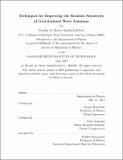Techniques for improving the readout sensitivity of gravitational wave antennae
Author(s)
Smith-Lefebvre, Nicolás de Mateo
DownloadFull printable version (44.45Mb)
Other Contributors
Massachusetts Institute of Technology. Dept. of Physics.
Advisor
Nergis Mavalvala and Peter Fritschel.
Terms of use
Metadata
Show full item recordAbstract
The detection of gravitational waves (GWs) from astrophysical sources shows promise as a new method to probe extremely energetic phenomena and test the strong field limit of the general theory of relativity. The era of the first generation of broadband interferometric GW antennae is now drawing to a close, and the construction of the second generation has begun. The Laser Interferometer Gravitational-wave Observatory (LIGO) in the United States is one component of a worldwide array of sites designed to collectively record and analyze these GW signals. In preparation for the next major phase of operation, named Advanced LIGO, an incremental upgrade and prototyping project known as Enhanced LIGO introduced several upgrades to the initial LIGO detectors. The addition of the output mode cleaner (OMC), a critically coupled optical cavity designed to filter undesired light from the output of the interferometer before the GW signal is sensed on a photodetector, was one of these upgrades. This work describes several lessons learned as a result of the installation and commissioning of the OMC in Enhanced LIGO. The techniques described in this thesis include the development of a novel OMC alignment system designed to maximally transmit the GW signal in the presence of contamination that would confound a typical automatic alignment system, a design for a remotely controllable automatic mode matching system for the OMC, and prescriptions for reducing the presence of beam jitter noise associated with the OMC. The designs of each of the future GW detectors include the use of an OMC, thus the techniques described in this thesis will be directly applicable to achieving the maximum sensitivity of these detectors.
Description
Thesis (Ph. D.)--Massachusetts Institute of Technology, Dept. of Physics, 2012. This electronic version was submitted by the student author. The certified thesis is available in the Institute Archives and Special Collections. Cataloged from student-submitted PDF version of thesis. Includes bibliographical references (p. 135-143).
Date issued
2012Department
Massachusetts Institute of Technology. Department of PhysicsPublisher
Massachusetts Institute of Technology
Keywords
Physics.